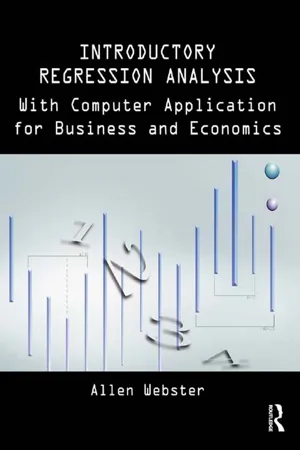![]()
Chapter 1
A REVIEW OF BASIC CONCEPTS
Introduction
1.1 The Importance of Making Systematic Decisions
1.2 The Process of Statistical Analysis
• Data Collection
• Organizing the Data
• Analyzing the Data
• Interpreting the Results
• Prediction and Forecasting
1.3 Our “Arabic” Number System
1.4 Some Basic Definitions
• Populations and Samples
• Sampling Error
• Sources of Sampling Error: Sampling Bias and Plain Bad Luck
• A Sampling Distribution
• Types of Variables
1.5 Levels of Data Measurement
• Nominal Data
• Ordinal Data
• Interval Data
• Ratio Data
1.6 Properties of Good Estimators
• A Good Estimator Is Unbiased
• A Good Estimator Is Efficient
• A Good Estimator Is Consistent
• A Good Estimator Is Sufficient
1.7 Other Considerations
1.8 Probability Distributions
1.9 The Development and Application of Models
1.10 “In God We Trust—Everybody Else Has to Bring Data”
Chapter Problems
Appendix: Excel Commands and Common Probability Distributions
• The Normal Distribution
• Student's t-Distribution
• The F-Distribution
• The Chi-Square Distribution
INTRODUCTION
This first chapter provides an important overview of the fundamental concepts relevant to a thorough understanding of statistical analysis. Basic terms and definitions that are commonly used in statistical studies are presented. These definitions are crucial to a complete understanding of what statistics is and what it can do for you. It is important for you to distinguish between populations and samples and to identify various types of variables used in statistical analysis.
The specific steps that should be taken in any statistical analysis are examined. This “statistics process” affords an organized and analytically structured procedure that can be followed to minimize the chance of error and ensures that all phases of a statistical study are completed.
Numerous types of data and the different ways in which they can be measured are presented. The levels of complexity and scale of refinement of data display must be considered in their analysis. Using data to draw conclusions for which they may be unsuitable is a common blunder committed by uninformed analysts. Many research efforts are impaired and the results corrupted by the improper use of data.
It is essential that researchers understand the concept behind the statistical procedures they perform. Without a full conceptual appreciation of statistical tools their use is severely limited. This text emphasizes the interpretation and application of statistical analysis as well as the mathematical process analysts must complete.
A conceptual understanding of the results of any statistical study is of paramount importance to the interpretation and application of statistical analysis. Merely “crunching the numbers” or performing the simple mathematical computations is of limited value.
1.1 THE IMPORTANCE OF MAKING SYSTEMATIC DECISIONS
As the business world becomes increasingly complex, so does the process of decision-making. As times have changed, so has the manner in which intelligent and informed choices must be made. No longer is it possible to continue some policy simply because “that's the way we've always done it” or “it's worked that way in the past.” Today it is necessary to decide courses of action only after a careful evaluation of all potential alternatives and the outcomes these options offer.
This thorough assessment requires a more systematic and analytical approach to the decision-making process. Flipping a coin simply isn't going to work. An examination of alternative procedures must involve the informed use of statistical tools that provide analytical insight into problem-solving. Only with the aid of rational thought offered by a statistical investigation can the decision-maker feel confident of his or her work. Through statistical analysis we are able to decrease the level of uncertainty and risk associated with the decision-making process.
This is true regardless of the field of study. Marketing executives must determine the potential for consumer acceptance of any new product they wish to introduce into the marketplace. The effort to market a new product that ultimately proves to be a failure can be quite disastrous. Many companies have suffered serious damage to their “bottom line” by rushing an untested product to market before fully evaluating its potential for market success. This unfortunate turn of events could have been avoided by a coherent review of market conditions.
Business managers must often decide which training program is optimal for their employees, what is the best form of transportation for their final product, and what are the desired levels of inventory that should be maintained. They face a wide array of crucial decisions that could be made more prudent through some form of statistical analysis.
Financial analysts are often faced with alternative sources of investment funds that can be used for various purposes. They must carefully evaluate different capital budgeting procedures to decide the most desirable method to finance their firm's operations.
Corporate accountants concern themselves with the relative effectiveness of different audit procedures. They frequently wish to identify the most effective method of drawing information from financial statements and evaluating the results of earlier corporate decisions. Economists must often estimate product demand, perform crucial cost analysis, and measure levels of competition within domestic as well as foreign markets. Estimating the shelf-life of their perishables, examining production schedules, and researching the character of competitive markets also fall within the scope of economists' daily tasks.
The applications of statistical analysis to the business decision-making process are unlimited. No aspect of business behavior escapes the vital scrutiny that can be provided only through a formal and detailed statistical process. The tools and techniques that make up statistical analysis allow businesses to derive vital and meaningful information from data they have collected for just that purpose. Making any consequential business decision in the absence of a statistical study is a hazardous prospect at best.
1.2 THE PROCESS OF STATISTICAL ANALYSIS
The statistical process takes on several clearly identifiable steps. We can examine each briefly in turn.
• Data Colle...
